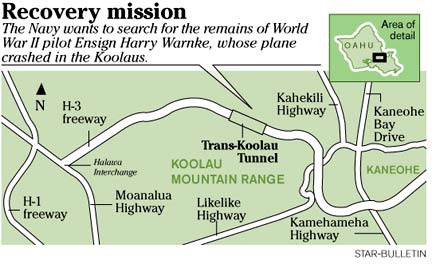About her brother, Navy aviator Harry Warnke, left, who died in a Koolau crash 61 years ago
Military to seek
WWII pilot’s remains
in Koolaus
More than six decades ago, a young Navy aviator died when he crashed his F-6F Hellcat fighter on the rugged Koolaus after a practice bombing run.
He was buried near the crash site, and his parents were told he had died at sea. Today, the family of Ensign Harry Warnke hope to recover his remains and bury him in a grave next to his parents in Westville, a small northern Indiana farming community.
Finding his remains and bringing them home "would be good," said Warnke's sister, Myrtle Tice, 85. "I would like this to happen."
"You give up hope after awhile," she said, but this time it may be different.
This week the Navy announced that it is seeking comment on an environmental assessment to recover the remains believed to be buried near the wreckage of the World War II fighter on state conservation land owned by the state departments of Transportation and Hawaiian Home Lands. The comment period for the assessment runs through June 7.
Warnke's remains are believed to be at the 2,600-foot level of a ravine in the Koolaus, near the southern entrance to the H-3 tunnel. The military hopes to begin the search and recovery by late summer.

After four simulated bombing runs, Warnke failed to rendezvous with his flight leader.
Rear Adm. F.E. Bakutis, then the commander of the Warnke's unit, Fighting Squadron 20, hiked to the crash site two days later and reported that the Hellcat was buried up to the tail.
In his report, Bakutis said, "The plane itself was badly broken up and scattered over a large area. Many of the parts were buried deep in the ground."
A shoe, believed to be Warnke's, was found during Bakutis' recovery mission. Warnke's remains were buried near the crash site, but the grave was never marked.
The recovery mission will be conducted by members of the Joint POW/MIA Accounting Command. They will have to remove heavy vegetation and excavate and screen a large area. Remains would be taken to a laboratory for identification.
This is a conservation area, and considered critical habitat for seven species of endangered or threatened plants. The Navy says it has surveyed the area and has not found threatened plants or animals. But as part of its recovery operation, it will replace any disturbed soils and vegetation.
Maj. Rumi Nielson-Green, Army spokesman for JPAC, said recovery operations are planned for late summer through early fall.
"This is because we don't have many off-island missions then, because of the monsoons and typhoons in Laos and Vietnam," said Nielson-Green, whose agency's mission is to recover remains of missing service personnel from all conflicts since World War II.
In February 1999, a nine-member JPAC team recovered two 90-pound propeller blades, pieces of the wreckage bearing Warnke's aircraft number, "82," and other pieces of his aircraft. The team determined it would take up to 60 days and as many as 40 soldiers to excavate the area.
The team didn't search for any remains. Another JPAC team revisited the site last year to do a routine site survey.
Tice, who now lives near Tucson, Ariz., said her parents had been told that her brother crashed into the ocean.
Twelve years ago, after she was told that a civilian had found the wreck of her brother's Hellcat, she wrote to U.S. Sen. John McCain asking for his help in getting the military to search the area.
"I would certainly accept the cremated remains of Henry Warnke. This would put an end to a sad event," she wrote. "The return of a body after the war would have eased my parents' grief. They are both deceased, but there is a headstone and plot for my brother with their graves."
A month ago, the Navy called her and said they had recovered pieces of the wreckage.
"I wonder today whether there is anything left," Tice said. "I have no idea after all those years if there is anything of him to recover."
[News] [Business] [Features] [Sports] [Editorial] [Do It Electric!]
[Classified Ads] [Search] [Subscribe] [Info] [Letter to Editor]
[Feedback]
